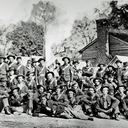Memorial Day: The tangled back story

Published Date: 5/27/2019
Source: axios.com
The history of Memorial Day is the subject of a longstanding academic smackdown, with dozens of cities and towns claiming to be the holiday’s birthplace.The backstory: Scholars agree that in 1868, three years after the Civil War’s end, Union Army General John A. Logan established a national holiday “for the purpose of strewing with flowers or otherwise decorating the graves of comrades who died in defense of their country.” What’s disputed is where he got the idea.Among the contenders:Columbus, Ga., where a Confederate widow who regularly decorated her husband’s grave wrote a widely published letter to the editor in 1866 calling for “a day to be set apart annually” for Southerners to observe this “sad but pleasant duty.” Columbus, Miss., where a small group of women gathered in 1866 to place flowers on the graves of both Confederate and Union soldiers, a gesture of reconciliation. Charleston, S.C., where African-American residents honored slain Union soldiers in a May Day ceremony in 1865.Waterloo, N.Y., where villagers marched “to the strains of martial music” in an 1866 parade to decorate soldiers’ graves.* (In 1966, President Lyndon Johnson declared Waterloo the birthplace of Memorial Day, though most scholars disagree.)There are even dueling Memorial Day research centers. One, at the University of Mississippi, supports the view that “so widespread was the impulse to honor the war dead that observances occurred spontaneously in several locations.”The other, at Columbus State University in Georgia, makes a persuasive case that the Confederate widow’s letter to the editor got the ball rolling.“We examine every claim in our [2014] book, and the vast majority are just disprovable myths,” Richard Gardiner of the Columbus State Center for Memorial Day Research told Axios.Literary bonus: Francis Miles Finch, a Northerner and Yale grad, was so touched by the Mississippi women who had decorated both Union and Confederate graves that he wrote a poem, “The Blue and the Gray,” that was published in The Atlantic in 1867. Its message — of a nation knitting together over the brave sacrifices of its soldiers — is one that resonates today.